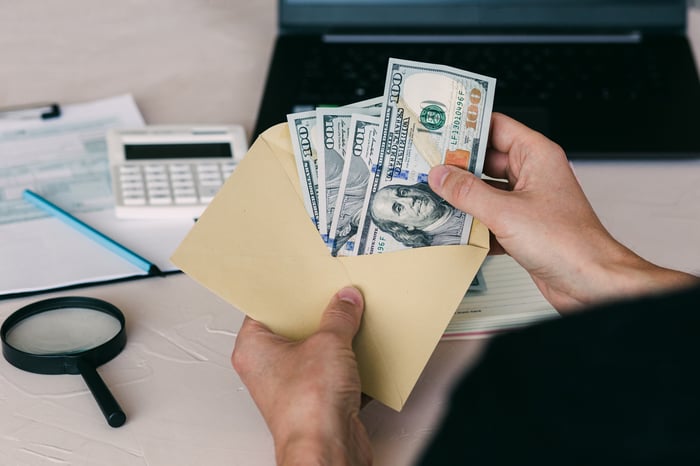A company that can consistently raise its dividend by a double-digit-percentage rate every year can make investors a lot of money in the long run.
One company investors may want to look at has been raising its dividend every year since it went public in 2008. Its most recent dividend increase added another 16% to shareholders' quarterly payments. And the best part is there's still a lot of room for the company to keep raising its dividend for years to come.
The company I'm describing is none other than fintech giant Visa (V 0.11%).
Here's why dividend growth stock investors should seriously consider adding Visa to their portfolio.

Image source: Getty Images.
A cash-generating machine
As a payments network, Visa benefits from scale, which creates a network effect and cost advantages over the competition. That allows Visa to grow its top line quickly with minimal investments since it's a clear choice for any bank looking to issue a new credit card.
Meanwhile, more and more payments are shifting from cash to digital. And Visa is a prime beneficiary of that trend. While digital payments account for the vast majority of in-store payments in the U.S., there's still a long way to go in other parts of the world where cash remains the primary means of payment, including Europe.
That's led to consistent double-digit revenue growth for Visa and equally strong free cash flow improvements. Revenue increased 11% over the last year while free cash flow improved 10%.
For fiscal 2023, free cash flow totaled a whopping $19.7 billion. That translates into a free-cash-flow-conversion rate of 60%.
That gives it a lot of cash to return to shareholders. And indeed, that's exactly what Visa does. It returned practically all $19.7 billion in free cash flow to investors in the form of share repurchases and dividends. The board recently authorized a new $25 billion multiyear share repurchase program along with the recent dividend increase.
A closer look at the dividend
After its most recent dividend increase, Visa will now pay shareholders $0.52 per share each quarter. That translates into an annual yield of about 0.89%. That might not seem like much now, but the potential is massive.
First of all, Visa paid just $3.75 billion in total dividend payments in fiscal 2023. That's less than 20% of its free cash flow. The 16% dividend increase would have it pay out a maximum of $4.35 billion this year. But it's also buying back shares at a rapid pace, which could save it a nice chunk of cash on the dividend. Even so, the dividend still represents a small portion of its steady and growing free cash flow.
There are few reasons to expect Visa to see a slowdown in its growth. Management expects revenue growth in the high-single-digit to low-double-digit range next year while exhibiting some operating leverage. That should result in strong free-cash-flow growth.

Image source: Getty Images.
The one thing that could slow Visa's growth is a recession or sudden reduction in consumer spending. Even if that were to happen, though, Visa's dividend looks very well protected, and it should be able to navigate through a macroeconomic slowdown relatively easily.
Visa could be even more aggressive with its dividend increases in the future, but management thinks it's prudent to focus on more share repurchases at this point in time. A share-repurchase program is more flexible than a dividend, as management has no obligation to exercise its authorization. However, management hasn't found much else to spend cash on other than its acquisition of Visa Europe last decade. So, it seems like the focus on share repurchases is a signal that management thinks the stock price still offers a lot of upside value.
Indeed, Visa shares currently trade at 28x trailing earnings and just 25x analysts' estimates for next year's earnings. That's below its historical average price above 32x earnings and also compares favorably to its biggest rival, Mastercard. The share price is enticing and the dividend has tons of room to increase for years to come. While the yield might be low today, investors could be raking in a lot of cash in just a few years as management continues to raise the dividend.





